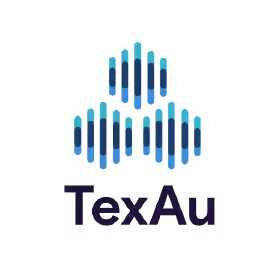Demandbase Alternatives
Considering a switch from Demandbase? Here are 10 alternatives, compared on features, pricing, and performance for an informed decision.

Demandbase is a popular tool for good reasons. It performs well for tasks like identifying a company's tech stack, accessing B2B data, and tracking website visitors. Many teams find it useful for their specific account-based marketing needs.
However, some users report a steep learning curve and find the pricing can be complex. For this reason, we've identified the best alternatives and analyzed their advantages compared to Demandbase to help you shortlist other options. Let's get started.
Our Recommendation: 11x
For teams interested in adding digital workers to their sales process, 11x is a notable choice. It provides autonomous agents to manage sales development, allowing your human reps to concentrate on higher-value activities like closing deals.
11x is a GTM platform that uses AI agents to manage the sales process. An agent named Alice finds prospects, handles outreach on email and LinkedIn, and maintains your CRM.
A second agent, Julian, qualifies inbound leads and books meetings. This approach consolidates data enrichment, outreach, and email warmup tools into a single platform.
Demandbase Alternatives
The following section provides a detailed review of each alternative. We cover pricing, core features, and the pros and cons of each tool compared to Demandbase.
1) 6sense
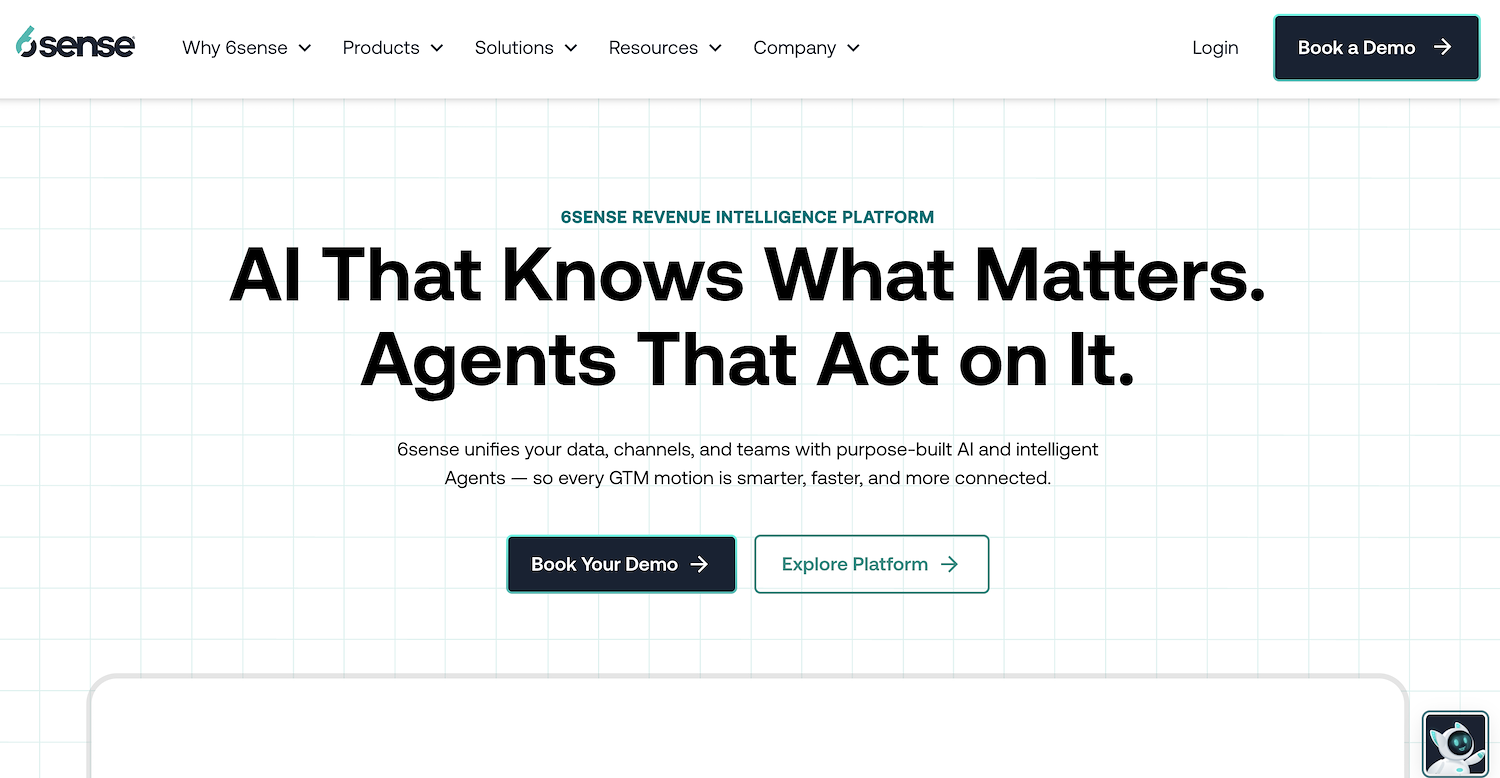
6sense is a revenue intelligence platform that unifies data for go-to-market teams. It uses its Signalverse data cloud to capture trillions of daily intent signals. The platform provides web deanonymization to identify site visitors, access to company and contact data, and technographics.
It predicts buyer readiness and automates actions across sales and marketing channels to connect teams with prospects who show intent to purchase.
6sense's Main Features
- Uses its 6AI engine to score, prioritize, and recommend actions from trillions of daily signals captured in its Signalverse data cloud.
- Provides a drag-and-drop canvas to build omni-channel campaigns across ads, email, web, and sales that are triggered by AI signals.
- Deploys autonomous AI email agents to personalize outreach, handle responses, and book meetings.
- Offers a Sales Copilot that delivers in-workflow insights to sellers, including prioritized accounts and automated research.
How 6sense Compares to Demandbase
Average Review score: 4.3/5 stars based on 1,086 G2 reviews
- 6sense provides autonomous AI agents that handle email outreach and book meetings, automating parts of the sales process that are often manual in Demandbase.
- Its predictive analytics engine recommends specific actions for teams to take, offering more direct guidance compared to the intent data presentation in Demandbase.
- The platform includes a drag-and-drop canvas to build omni-channel campaigns, which can simplify campaign creation for users who find Demandbase's interface complex.
- It offers a Sales Copilot feature that delivers insights directly to sellers, providing a more integrated sales enablement tool than what is available in Demandbase.
Potential Drawbacks Compared To Demandbase
- Some users find that the contact or company data in 6sense can occasionally be less accurate. This may require more verification compared to the data provided within Demandbase's platform.
- The platform relies on integrations for some advanced advertising functions. In contrast, Demandbase includes a native, self-serve advertising platform that gives users more direct control over ad campaigns.
- While 6sense offers website personalization, some teams may find Demandbase's tools for site optimization and A/B testing more extensive. This allows for more granular control over the on-site visitor experience.
Pricing and Cost-Effectiveness
Both platforms offer custom pricing, so a direct comparison isn't possible without a formal quote. User reviews indicate a high perceived cost for 6sense, while Demandbase is known for complex pricing structures. We recommend contacting both vendors for detailed information tailored to your needs.
2) Terminus Account-Based Marketing Platform
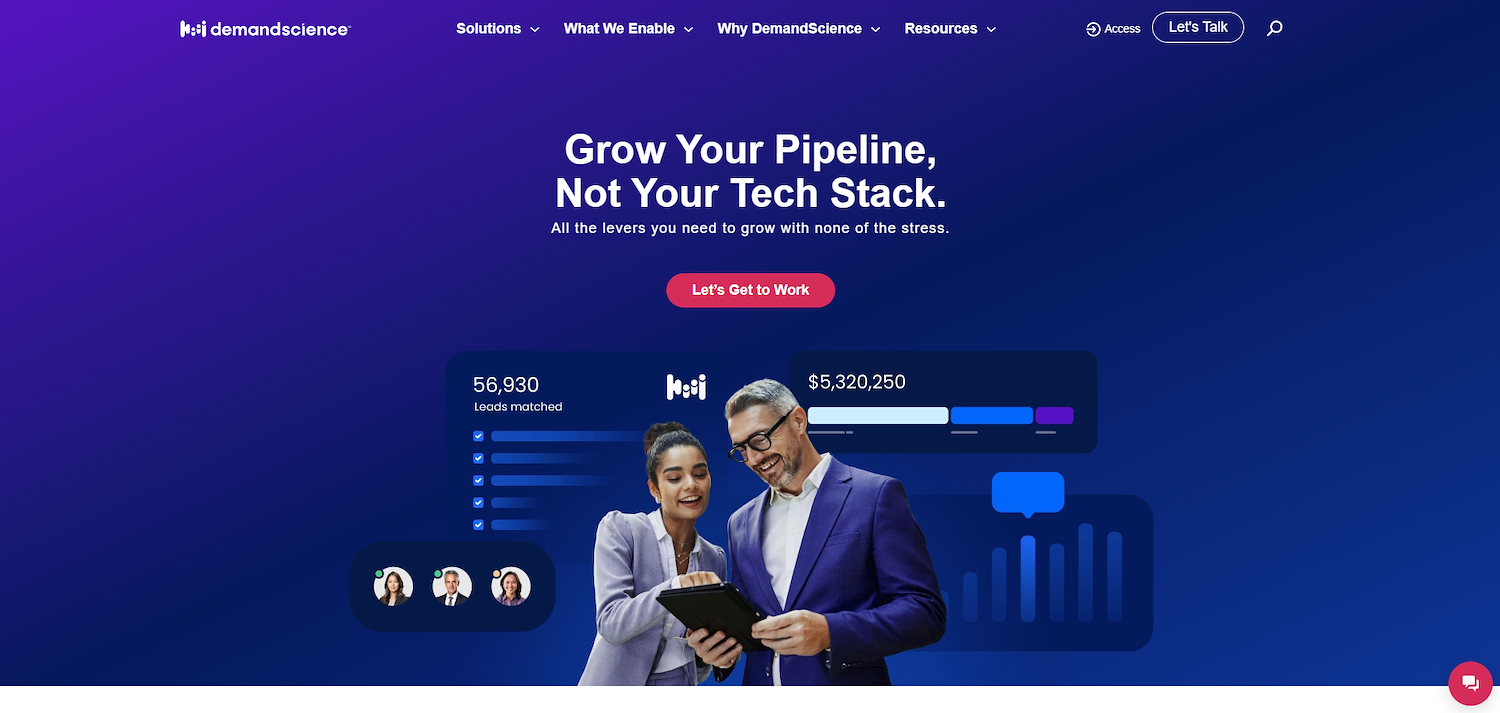
The Terminus Account-Based Marketing Platform supports go-to-market teams with their account-based plans. It offers a B2B database, website visitor tracking, and technographic data. These tools help identify target accounts, monitor site engagement, and understand a prospect's technology stack for better outreach.
Terminus Account-Based Marketing Platform's Main Features
- Provides a B2B database with company and contact information to help teams build and prioritize target account lists.
- Identifies anonymous website visitors and tracks their on-site behavior to reveal which accounts are actively engaged.
- Offers technographic data that shows the technology stacks of target accounts for more relevant outreach and product positioning.
How Terminus Compares To Demandbase
Average Review score: There are not enough reviews on G2 to provide buying insight.
- Terminus provides native live chat and chatbot features. This allows for immediate engagement with website visitors, a more direct interaction compared to Demandbase's focus on the identification of anonymous traffic.
- The platform includes email signature marketing. This feature uses employee emails as a marketing channel, an approach not offered within the core Demandbase toolset.
- It integrates multiple channels like chat, ads, and email signatures into one platform. This can offer a more unified campaign management experience than Demandbase, which may require separate integrations for similar coverage.
- This tool offers attribution features to measure performance across its channels. This provides a complete view of how different touchpoints contribute to revenue, which is different from Demandbase's analytics that focus more on intent signals.
Potential Drawbacks Compared To Demandbase
- Demandbase provides a native, self-serve advertising platform for direct campaign control. Some users may find Terminus requires more reliance on integrations for advanced advertising features.
- The platform's website personalization tools may not be as extensive as those in Demandbase. For example, Demandbase offers more comprehensive A/B testing features for granular site optimization.
- Some users report that the predictive analytics in Demandbase are more advanced. Demandbase uses its data to forecast buying behavior, which can offer deeper insights than the intent signals available in Terminus.
Pricing and Cost-Effectiveness
Both Demandbase and Terminus use custom pricing, so a direct comparison requires a formal quote. While Demandbase is known for complex pricing structures, Terminus does not publicly list its costs. For the most accurate information, we recommend visiting the Terminus Account-Based Marketing Platform's official website.
3) RollWorks ABM Platform
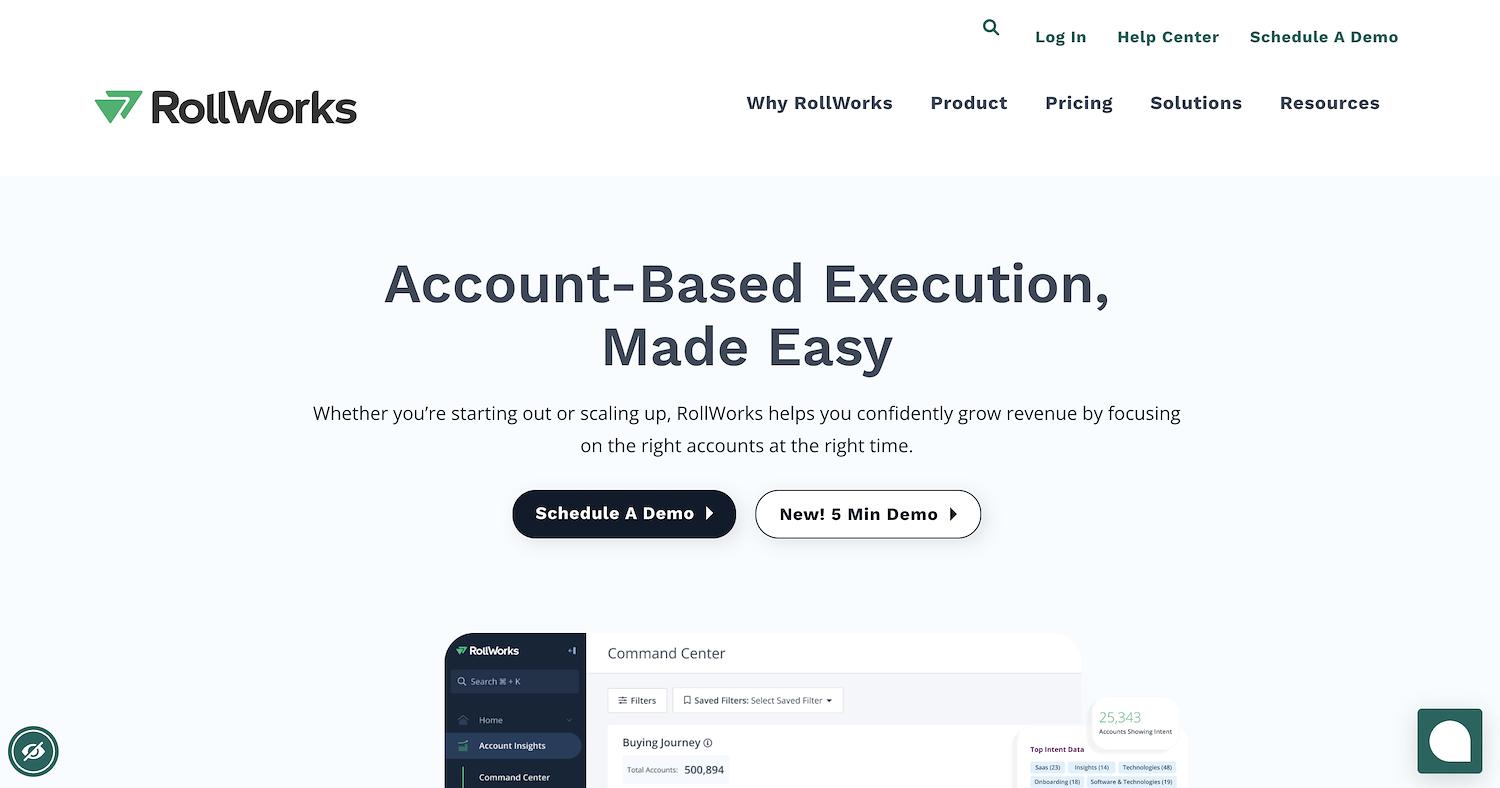
The RollWorks ABM Platform is an account-based solution for B2B marketing and sales teams. It bundles marketing and advertising capabilities to help teams focus on the right accounts. The platform uses intelligence and AI-driven targeting to identify best-fit accounts, surface buyer insights, and coordinate engagement across channels. It is designed to align sales and marketing efforts around target accounts and measure the contribution of these programs to revenue.
RollWorks ABM Platform's Main Features
- Identifies best-fit target accounts, segments them into tiers, and surfaces buyer insights with actionable recommendations.
- Uses AI-driven account- and persona-based targeting for display ads and provides reporting that ties ad spend directly to revenue growth.
- Coordinates advertising, sales, and marketing touchpoints for each account to align engagement efforts.
- Offers add-on tools such as a custom ABM play generator for ready-made plays and an in-market account finder to discover active buyers.
How RollWorks Compares To Demandbase
Average Review score: 4.3/5 stars based on 513 G2 reviews
- RollWorks is often noted for its ease of use. Teams may find its interface more straightforward to navigate compared to the reported complexity and steep learning curve of Demandbase.
- It provides deep, native integrations with key platforms like HubSpot and Salesforce. This creates a tightly connected workflow, which differs from Demandbase's more self-contained ecosystem.
- The platform excels at contact-level ad targeting and retargeting across display and social channels. This offers a granular approach to advertising that complements the account-level focus of Demandbase.
- Its Journey Stages feature gives clear visibility into where each account sits in the buying process. This provides a structured view of pipeline progression, a different perspective from Demandbase's intent signal analysis.
Potential Drawbacks Compared To Demandbase
- Demandbase provides more advanced predictive analytics to forecast buying behavior, while RollWorks focuses more on identifying current intent signals from accounts.
- Some teams might find that Demandbase's native, self-serve advertising platform offers more direct control over ad campaigns compared to the setup in RollWorks.
- The tool's features for website personalization and A/B testing can be less extensive than those in Demandbase, which may limit options for optimizing the on-site visitor experience.
Pricing and Cost-Effectiveness
While we've covered key features and use cases in this comparison, pricing models can vary significantly between tools. For the most accurate and up-to-date pricing information, we recommend visiting RollWorks ABM Platform's official website.
4) ZoomInfo MarketingOS
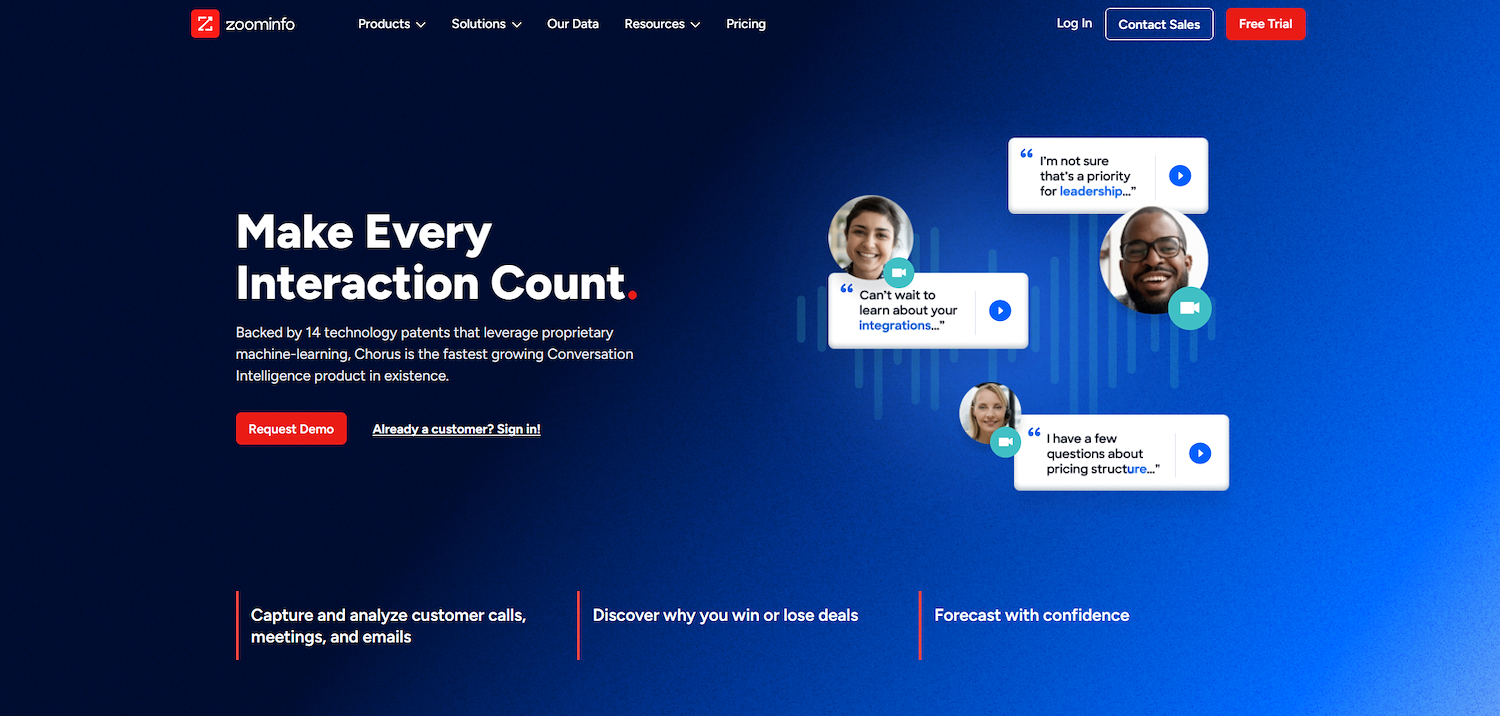
ZoomInfo MarketingOS is a go-to-market platform with a B2B database for sales and marketing teams. It provides technographics to detail a company's technology stack. The platform also identifies website visitors and shows which accounts engage with your site.
ZoomInfo MarketingOS's Main Features
- Offers a B2B database to help sales and marketing teams build contact and company lists.
- Provides technographic data that details the technology stack of prospective accounts.
- Identifies anonymous website visitors and tracks which accounts are engaging with your site content.
How ZoomInfo MarketingOS Compares To Demandbase
Average Review score: 4.4/5 stars based on 150 G2 reviews
- ZoomInfo MarketingOS provides access to extensive contact data. This allows for more granular, person-based outreach compared to the primarily account-level data focus within Demandbase.
- It includes native live chat and chatbot features for immediate website engagement. This offers a direct line for communication, different from Demandbase's method to identify anonymous visitors for later outreach.
- The platform uses a predictive score to rank prospects on their purchase path. This provides a clear hierarchy for sales outreach, a different approach from the broader intent signal analysis in Demandbase.
- This tool supports engagement across multiple channels, including SMS. The addition of SMS as a channel provides a communication option not natively available in the Demandbase platform.
Potential Drawbacks Compared To Demandbase
- Some users may find that Demandbase's predictive analytics offer more advanced forecasting of future buying behavior. This is different from ZoomInfo's predictive score, which primarily ranks accounts based on their current position in the buying journey.
- The platform's website personalization tools might feel less extensive than those in Demandbase. For example, Demandbase provides more comprehensive A/B testing options, which can give teams more granular control over optimizing the on-site visitor experience.
- While strong on contact data, its account-level insights can sometimes feel less cohesive than Demandbase's. Demandbase builds its platform around an account-centric view, which some teams may find provides a clearer picture of an entire organization's intent.
- Some users report that the contact data, while extensive, can occasionally be outdated. This may require teams to spend more time on verification compared to the data quality within Demandbase.
Pricing and Cost-Effectiveness
Both platforms use custom pricing. User reviews indicate ZoomInfo MarketingOS is perceived as expensive, while Demandbase is known for complex pricing structures. For the most accurate information, we recommend visiting ZoomInfo MarketingOS's official website.
5) Metadata.io
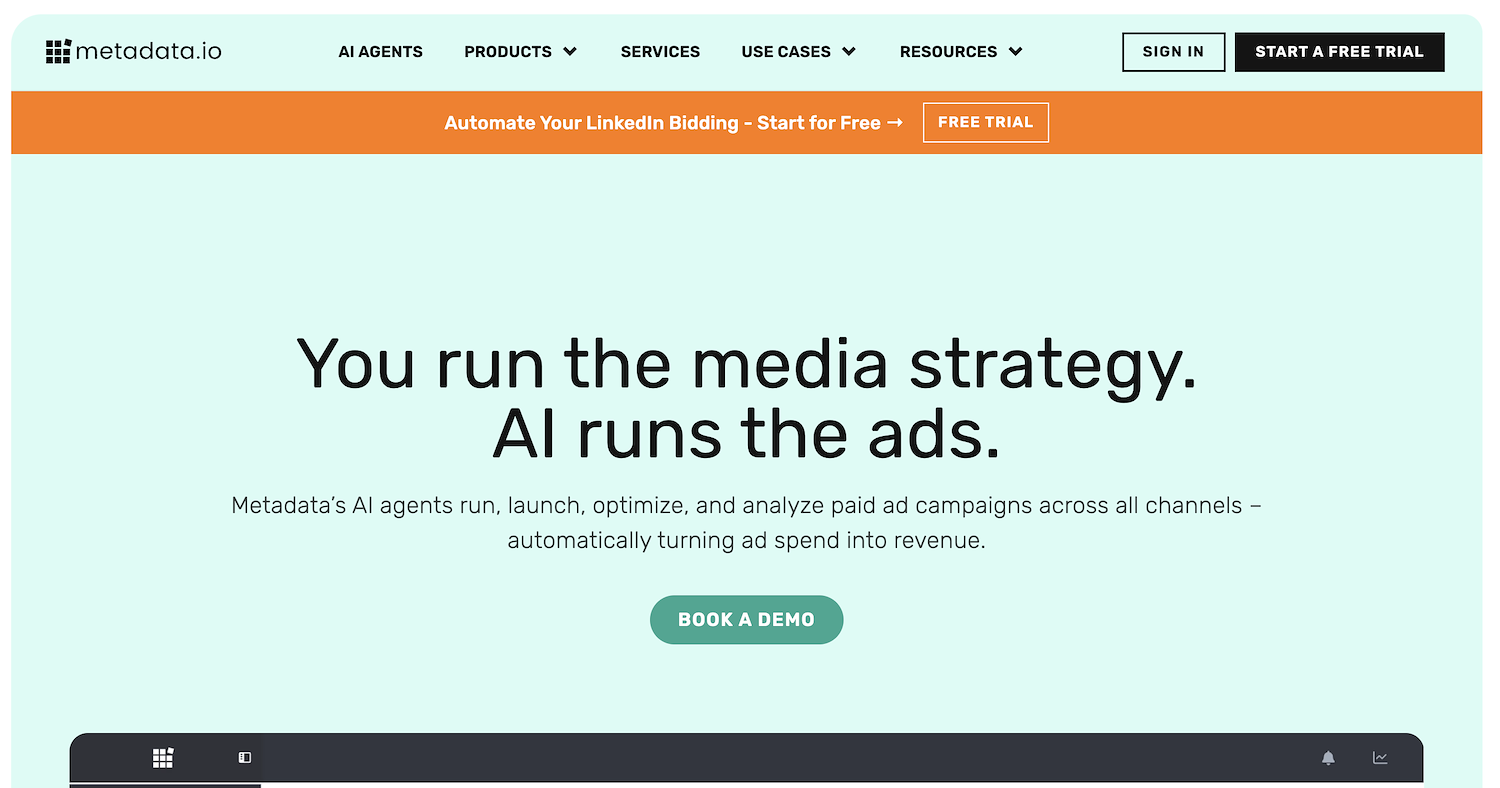
Metadata.io is a platform for B2B demand generation. It automates paid campaigns to help teams target specific accounts. The system uses data to create audiences for ads on social media. It provides options for users who require technographics, a B2B database, or identification of website visitors.
Metadata.io's Main Features
- Deploys AI agents to automate paid media workflows, including a Bid Agent for LinkedIn, a Targeting Agent for audiences, and an Analyst Agent for real-time insights.
- Connects directly to a company's CRM to optimize ad spend based on pipeline and revenue data, not just leads.
- Automates multivariate testing at scale to find the best-performing combinations of creative, offers, audiences, and channels.
- Builds audiences using a patented engine that matches over 1.5 billion emails from more than ten data partners.
How Metadata.io Compares To Demandbase
Average Review score: 4.6/5 stars based on 293 G2 reviews
- Metadata.io uses AI agents to automate paid media workflows, including bidding and audience targeting. This is different from Demandbase, which uses AI more for predictive analytics and intent signal analysis.
- The platform connects directly to a company's CRM to optimize ad spend based on pipeline and revenue data. This offers a different approach compared to Demandbase, which focuses its ad platform on account-level intent.
- It automates multivariate testing for ad campaigns to find the best-performing combinations of creative and audiences. This provides a more granular testing capability than the A/B testing features in Demandbase.
- This tool builds audiences for paid campaigns using a patented engine that draws from multiple data partners. Demandbase, in contrast, builds its audiences primarily from its own intent data and first-party signals.
Potential Drawbacks Compared To Demandbase
- Demandbase offers predictive analytics to forecast future buyer intent. In comparison, Metadata.io focuses its AI on the optimization of active campaigns with existing CRM data, which may provide less insight about accounts that will soon enter a purchase cycle.
- The platform's features for website personalization are not as extensive as those in Demandbase. For example, Demandbase provides more comprehensive A/B testing options, which gives teams more granular control over the on-site visitor experience.
- Some teams might find that Demandbase captures a broader range of third-party intent signals. Metadata.io's analysis centers on ad engagement and CRM data, which could offer a less complete view of an account's research activities across the web.
Pricing and Cost-Effectiveness
While we've covered key features and use cases in this comparison, pricing models can vary significantly between tools. For the most accurate and up-to-date pricing information, we recommend visiting Metadata.io 's official website.
Final Recommendation: 11x
If your goal is to automate sales development with digital workers, 11x is a relevant option. Its AI agents manage prospecting, outreach, and CRM updates. This approach frees up your sales team to focus on closing deals and other revenue-generating activities.
With 11x, we use AI to run the sales playbook. An agent named Alice finds accounts, enriches data, and handles outreach. Julian qualifies leads and books meetings. This approach combines intent data and email warmup into one platform, reducing the need for extra tools.
To see how it works, book a demo.
6) Madison Logic Platform
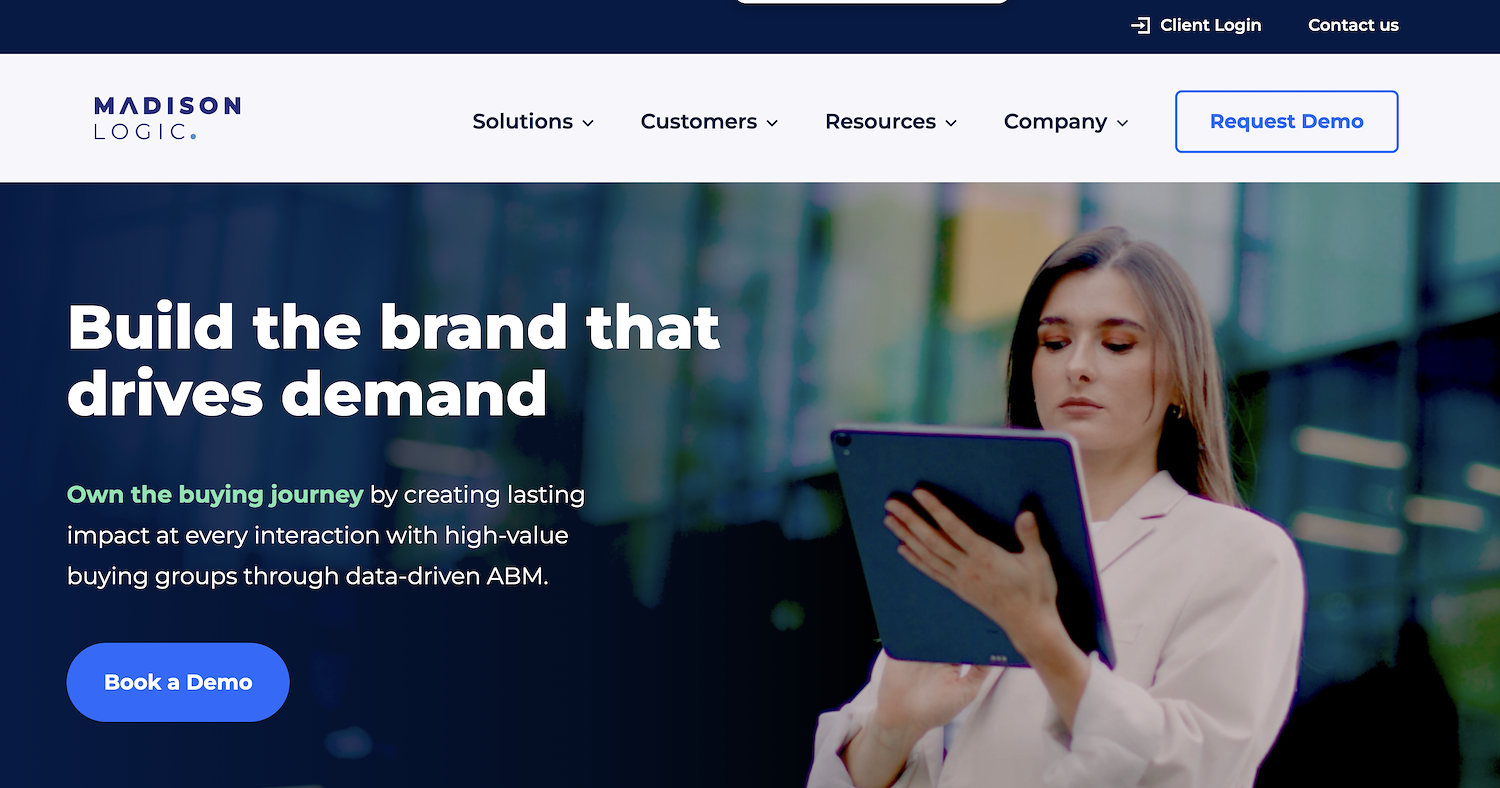
The Madison Logic Platform is an account-based marketing solution for go-to-market teams. It helps identify and engage target accounts. The platform offers a B2B database, technographics, and website visitor identification to support these efforts.
These features allow teams to build account lists, see a prospect's technology, and track website engagement. The system is designed to focus marketing and sales work on relevant accounts.
Madison Logic Platform's Main Features
- Uses ML Insights to analyze AI-powered intent data and prioritize accounts that are actively in-market.
- Serves tailored content to verified audiences through its ABM content syndication capabilities.
- Delivers targeted advertising to buying committees across channels like Connected TV, audio streaming, and LinkedIn.
- Connects campaign performance to pipeline and revenue impact using its ML Measurement cross-channel analytics.
How Madison Logic Compares To Demandbase
Average Review score: 4.3/5 stars based on 227 G2 reviews
- Madison Logic Platform provides ABM content syndication to serve tailored content directly to verified audiences. This is a different approach compared to Demandbase, which focuses more on analyzing intent signals to guide outreach.
- It delivers targeted advertising across channels like Connected TV and audio streaming. This expands reach beyond the typical display and social channels available within Demandbase's advertising platform.
- The tool connects campaign performance directly to pipeline and revenue impact with its cross-channel analytics. This offers a different measurement focus than Demandbase, which emphasizes the analysis of account-level intent signals.
- This platform unifies lead generation with display advertising in its core offering. Demandbase, in comparison, centers its platform more on identifying anonymous account activity and predicting future intent.
Potential Drawbacks Compared To Demandbase
- Madison Logic Platform's analytics focus on current buying signals. In comparison, Demandbase uses predictive models to forecast future intent. This can give teams a longer-term view of which accounts will enter a buying cycle.
- The tools for website personalization might feel less extensive. Demandbase, for example, provides more comprehensive A/B testing features. This allows for more granular control over the on-site visitor experience.
- Some users note less direct control over advertising campaigns. Demandbase includes a native, self-serve ad platform. This gives teams more hands-on management of their ad setup and execution compared to a more managed approach.
Pricing and Cost-Effectiveness
Both platforms use custom pricing, so a direct comparison requires a formal quote. User reviews indicate a high perceived cost for Madison Logic Platform, while Demandbase is known for complex pricing structures. For the most accurate information, we recommend visiting the Madison Logic Platform's official website.
7) Triblio ABM Platform
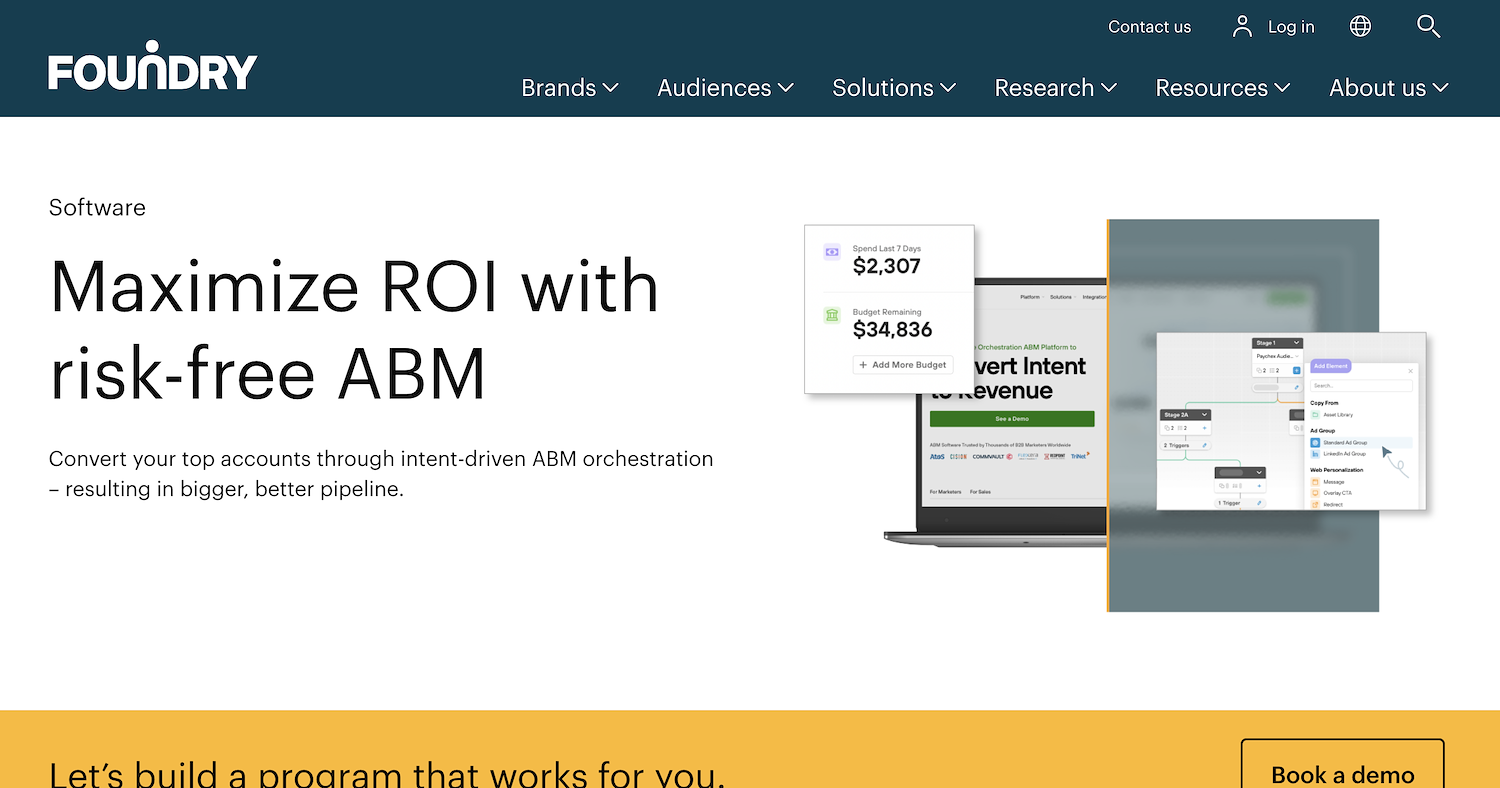
The Triblio ABM Platform is an account-based marketing solution for B2B teams. It helps orchestrate campaigns for specific accounts. The platform offers a B2B database to build lists and technographics to see a prospect's technology.
It also provides website visitor identification. This feature shows which accounts engage with your site and helps focus sales and marketing work on relevant targets.
Triblio ABM Platform's Main Features
- It orchestrates multi-channel campaigns across display, social, and email, which are triggered by account activity or intent signals.
- The platform personalizes website pages, overlays, and offers based on account data and intent signals.
- It pushes intent insights and recommended next-best actions directly into a team's CRM or sales engagement platform.
- The system aggregates intent signals from a company's website, the public web, and its own opted-in audience to deliver contact-level data.
How Triblio Compares To Demandbase
Average Review score: 4.2/5 stars based on 201 G2 reviews
- Triblio orchestrates campaigns across multiple channels that are triggered by specific account activity. This is different from Demandbase, which focuses more on campaigns based on broader intent signals.
- The platform pushes intent insights and suggests next-best actions directly into a team's CRM. This provides more direct sales guidance within existing workflows compared to the self-contained analytics in Demandbase.
- It delivers contact-level intent data by combining signals from a company's website and the public web. This offers a more granular view for outreach than Demandbase, which primarily provides account-level insights.
- Many users find the interface allows for quicker campaign setup. This can be a contrast to Demandbase, where some users report a steeper learning curve.
Potential Drawbacks Compared To Demandbase
- Demandbase uses predictive models to forecast future buying intent. In comparison, Triblio's analytics focus on current buying signals, which may offer less insight into which accounts will enter a purchase cycle later.
- The platform's campaign orchestration can feel more managed. In contrast, Demandbase provides a native, self-serve advertising platform that gives teams more direct, hands-on control over their ad campaigns.
- Some teams may find Demandbase captures a wider array of third-party signals. Triblio aggregates intent signals from a company's website and the public web, which can sometimes provide a less complete picture of an account's research.
Pricing and Cost-Effectiveness
Both platforms use custom pricing, so a direct comparison requires a formal quote. User reviews suggest Triblio has a high perceived cost, while Demandbase is known for complex pricing structures. For the most accurate information, we recommend visiting the Triblio ABM Platform's official website.
8) Jabmo
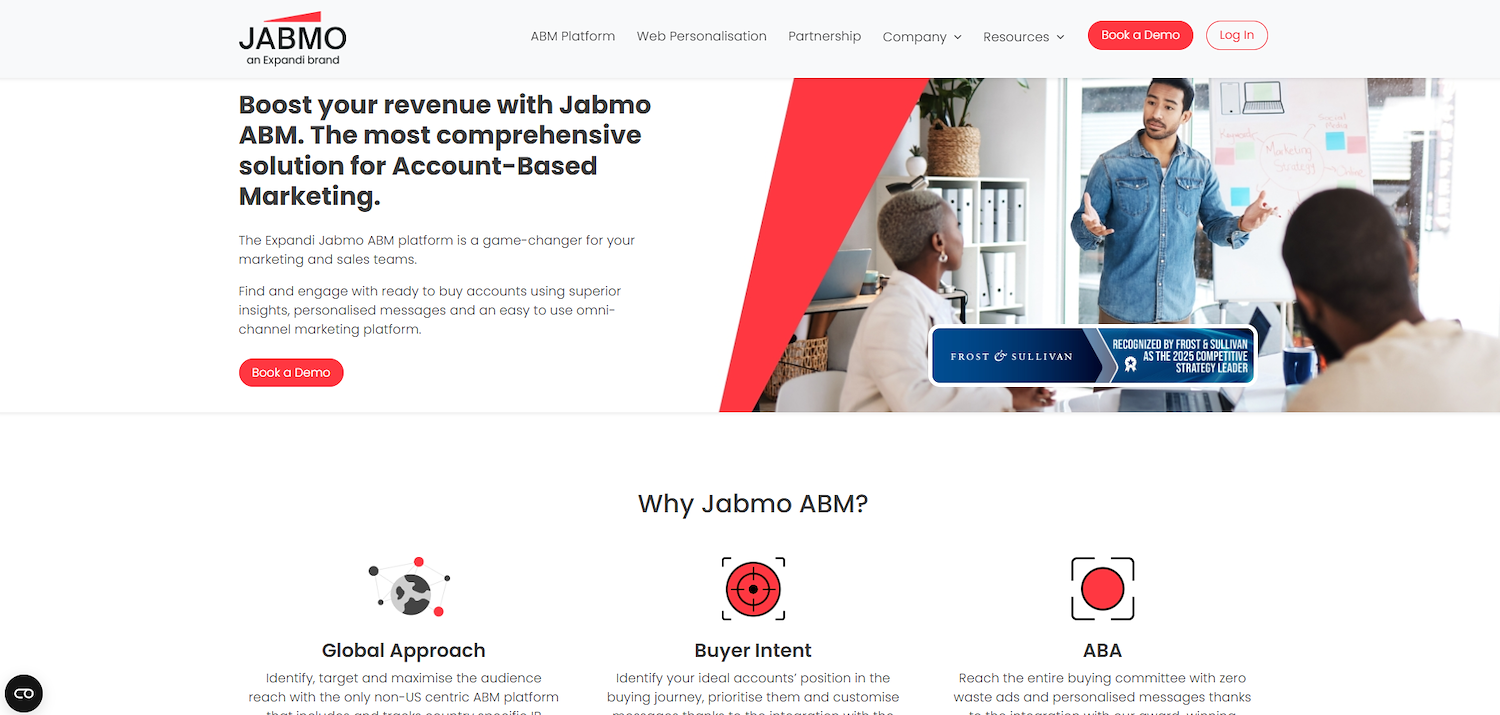
Jabmo is an account-based marketing platform for B2B companies. It helps teams identify and engage target accounts. The platform offers a B2B database, technographics, and website visitor identification to support sales and marketing work.
These features allow teams to build account lists, see a prospect's technology, and track website engagement. The system directs sales and marketing efforts toward specific accounts.
Jabmo's Main Features
- Shows engagement across all advertising channels in one place at the account level.
- Predicts future engagement using machine learning.
- Identifies all accounts visiting the website and uses a proprietary intent score to flag accounts ready for sales.
- Provides native marketing automation tools to guide known contacts through a marketing journey.
How Jabmo Compares To Demandbase
Average Review score: 4.1/5 stars based on 44 G2 reviews
- Jabmo includes native marketing automation tools to guide known contacts through a specific marketing journey. This provides a built-in nurturing function, while Demandbase often integrates with external platforms for this task.
- It provides a unified view of account engagement across all advertising channels in a single dashboard. This is different from Demandbase, which focuses more on analyzing intent signals from various sources to predict future behavior.
- The platform offers significant support, including in-house designers for quick ad creation. This managed approach contrasts with Demandbase's self-serve advertising platform, which gives users more direct control.
- This tool uses a proprietary intent score to flag accounts ready for sales based on their website activity. In comparison, Demandbase combines a wider range of third-party intent signals for its analysis.
Potential Drawbacks Compared To Demandbase
- Demandbase uses predictive analytics to forecast future buying behavior. In comparison, Jabmo's machine learning predicts engagement based on current activity, which may offer less insight into accounts that will enter a buying cycle later.
- Some users report that the platform's website personalization tools are less developed. Demandbase, for example, provides more comprehensive A/B testing features, which allows for more granular control over the on-site visitor experience.
- The tool offers limited self-service options, with some users noting a preference for more direct control. This is different from Demandbase, which includes a native, self-serve advertising platform for hands-on campaign management.
Pricing and Cost-Effectiveness
Both platforms use custom pricing, so a direct comparison requires a formal quote. User reviews indicate Jabmo has a high perceived cost, while Demandbase is known for complex pricing structures. For the most accurate information, we recommend visiting Jabmo's official website.
9) MRP Prelytix
MRP Prelytix is an account-based marketing platform for enterprise companies. It helps teams identify and engage buying committees within target accounts. The platform provides a B2B database, technographics, and website visitor identification to support sales and marketing efforts.
MRP Prelytix's Main Features
- Uses predictive analytics to identify accounts that show buying intent and prioritizes them for outreach.
- Orchestrates multi-channel campaigns across display, social, email, and direct mail to engage buying committees.
- Provides real-time intent data from a global cooperative of B2B data sources.
- Delivers sales insights and alerts directly to sales teams to inform their outreach efforts.
How MRP Prelytix Compares To Demandbase
Average Review score: 4.3/5 stars based on 131 G2 reviews
- MRP Prelytix is often used by large, global enterprises. Its platform is built to handle complex sales cycles and multi-region campaigns, which can be a different focus from Demandbase's typical use case.
- The platform includes direct mail as a native channel for campaign orchestration. This provides an offline touchpoint that is not a standard feature within the Demandbase toolset.
- It offers managed services for campaign execution. This provides hands-on support, which contrasts with the self-serve model of Demandbase's advertising platform.
- Its intent data comes from a global B2B data cooperative. This provides a different source of insight compared to the third-party intent signals aggregated by Demandbase.
Potential Drawbacks Compared To Demandbase
- The platform's reliance on managed services may offer less direct control for teams that prefer a hands-on, self-serve approach to campaign management, like the one available in Demandbase.
- Some users might find that Demandbase's predictive analytics offer a different type of insight. Demandbase focuses on forecasting future buying behavior, while MRP Prelytix identifies current intent.
- Teams that require extensive website personalization and A/B testing may find the features within Demandbase to be more comprehensive for optimizing the on-site visitor experience.
Pricing and Cost-Effectiveness
Both platforms use custom pricing, so a direct comparison requires a formal quote. User reviews suggest MRP Prelytix is positioned for enterprise budgets, while Demandbase is known for complex pricing. For details, we recommend visiting the MRP Prelytix official website.
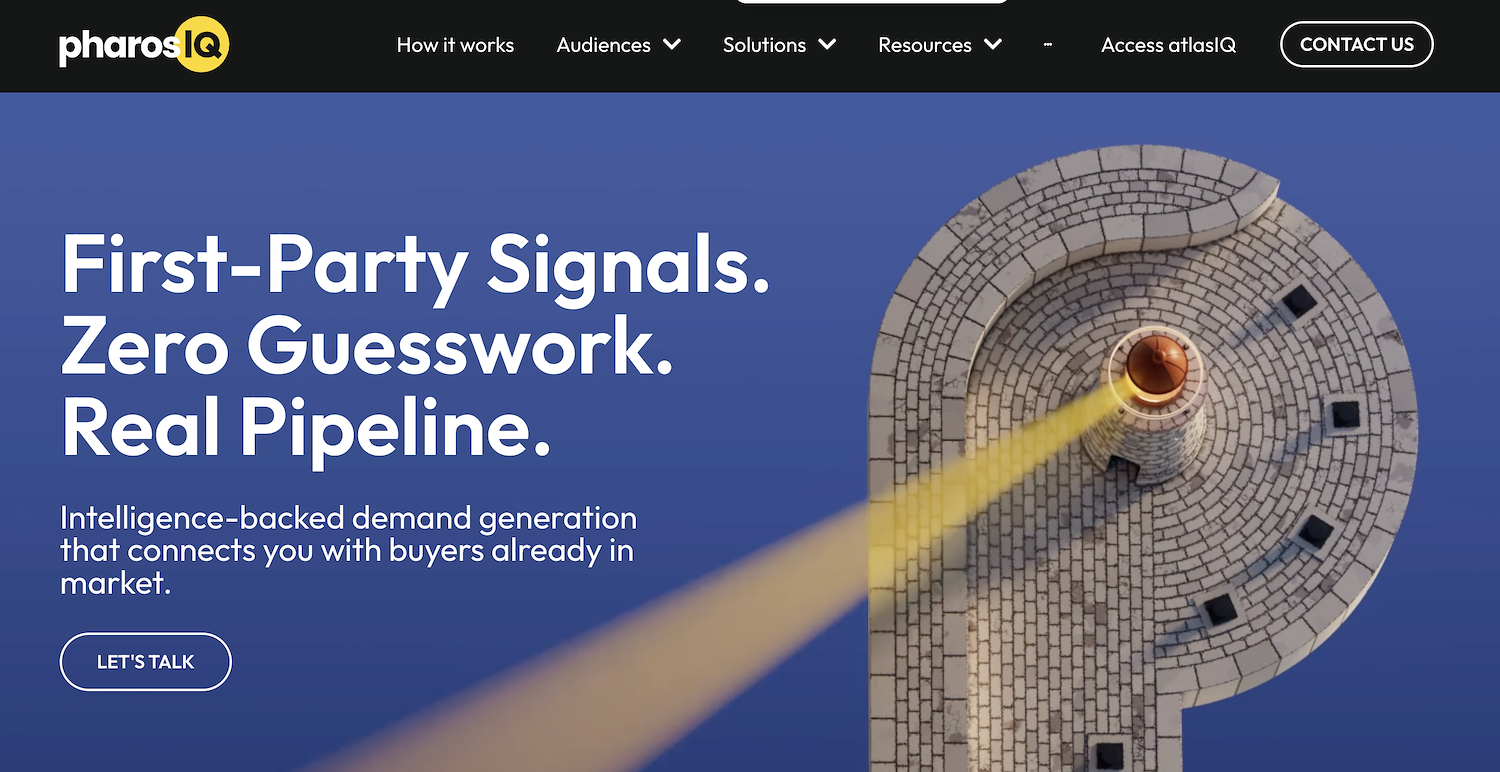
MRP Prelytix is an account-based platform for enterprise companies. It helps teams identify and engage buyer groups inside target accounts. The platform offers a B2B database, technographics, and website visitor identification.
MRP Prelytix's Main Features
- Syndicates B2B content like pricing guides and case studies to high-intent buyers.
- Appends mobile phone data to existing leads to expand contact information.
- Creates custom B2B events to engage with prospective accounts.
- Provides free "intent-to-purchase" data to help identify active buyers.
How MRP Prelytix Compares To Demandbase
Average Review score: 4.2/5 stars based on 17 G2 reviews
- MRP Prelytix syndicates content like pricing guides directly to high-intent buyers. This approach is different from Demandbase, which uses intent signals to guide general outreach.
- It appends mobile phone data to existing leads, which provides an additional contact channel not standard in Demandbase's data enrichment.
- The platform creates custom B2B events to engage with prospective accounts. This is a service-based feature for direct interaction, unlike the digital campaign focus in Demandbase.
- This tool provides some "intent-to-purchase" data for free, while the intent data from Demandbase is part of its core paid platform.
Potential Drawbacks Compared To Demandbase
- Its integration with platforms like Salesforce sometimes uses an iFrame. This approach can feel less seamless than the native connections available within Demandbase.
- Some users find the user interface clunky and the onboarding process a challenge. This differs from Demandbase, where complexity often relates to feature depth, not UI navigation.
- The setup for custom reports is sometimes not intuitive, which can lead to errors. Demandbase, in contrast, builds its platform around its analytics suite, providing more direct reporting workflows.
Pricing and Cost-Effectiveness
Both platforms use custom pricing, so a direct comparison requires a formal quote. User reviews note a high initial cost for MRP Prelytix, while Demandbase is known for complex pricing. For details, we recommend visiting the MRP Prelytix official website.
10) Dealfront (Leadfeeder)
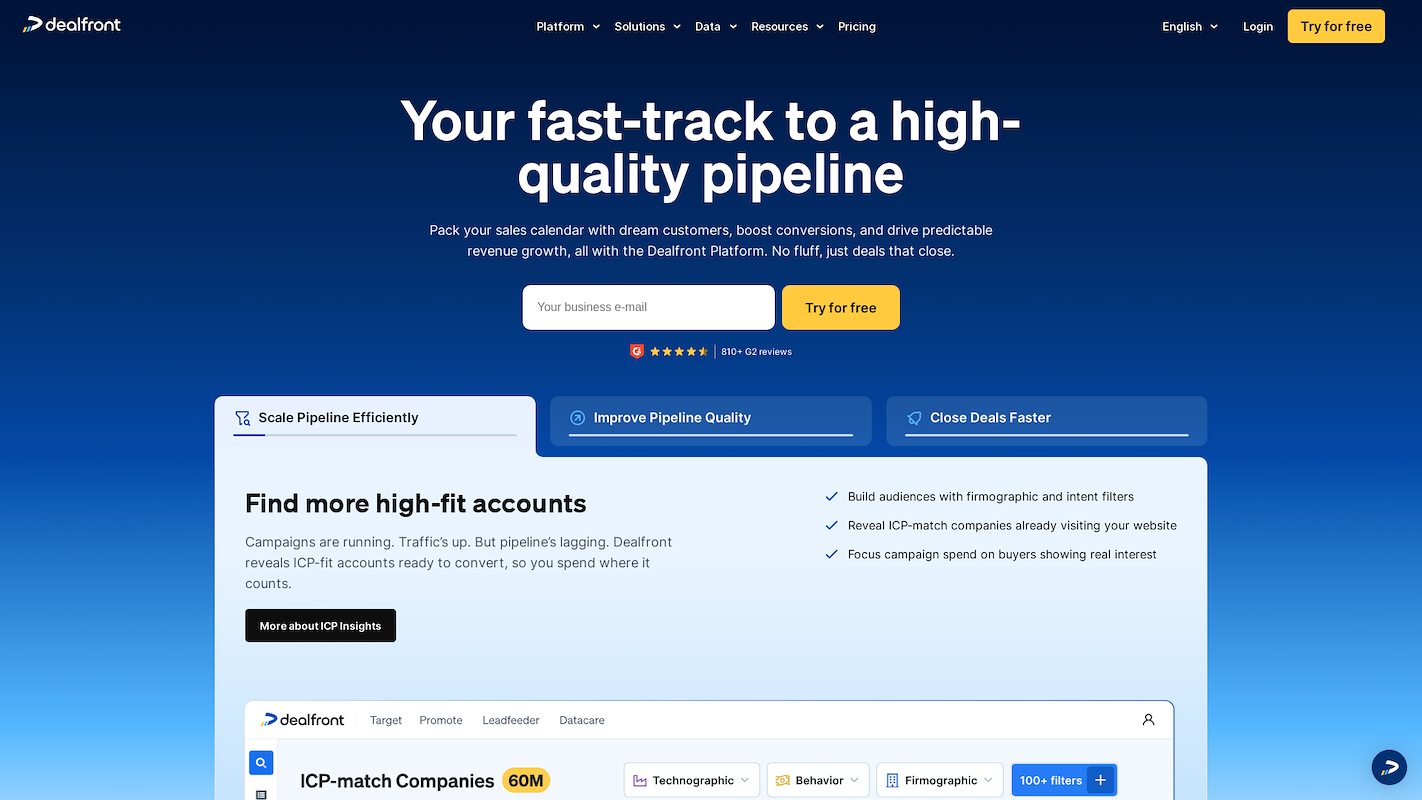
Dealfront (Leadfeeder) is a go-to-market platform for B2B companies. It provides tools to identify and engage target accounts. The platform includes a B2B database, technographics, and website visitor identification to help teams build account lists and track engagement from prospects.
Dealfront (Leadfeeder)'s Main Features
- Identifies anonymous companies visiting the website and provides profiles with details like industry, size, and location.
- Analyzes visitor behavior by tracking page visits, duration, and frequency to gauge interest and intent.
- Scores leads automatically based on engagement levels and segments them using criteria such as industry and on-site behavior.
- Provides real-time alerts when target companies visit the website, enabling timely sales follow-up.
How Dealfront Compares To Demandbase
Average Review score: 4.3/5 stars based on 730 G2 reviews
- Dealfront provides real-time alerts when a target company visits your website, which allows for immediate sales follow-up. This is different from Demandbase, which focuses more on analyzing intent signals over time.
- The platform analyzes specific visitor behavior, such as page views and visit duration, to show precise interest. This offers a more granular view of on-site engagement compared to the broader intent topics that Demandbase aggregates.
- It scores leads automatically based on direct website engagement, helping sales teams prioritize accounts that are actively interacting with the site. In comparison, Demandbase uses predictive models to score accounts based on a wider range of intent signals.
- This tool offers a straightforward user experience for identifying website visitors. Some teams may find this more direct than the interface of Demandbase, which can have a steeper learning curve due to its extensive features.
Potential Drawbacks Compared To Demandbase
- Demandbase uses predictive analytics to forecast future buying intent. In comparison, Dealfront's analysis centers on current website activity, which may provide less insight into accounts that will soon be in-market but are not yet visiting your site.
- The platform does not include a native advertising platform. Demandbase, in contrast, provides a self-serve ad platform that allows teams to manage and execute their own account-based advertising campaigns directly within the tool.
- Some teams may find the options for website personalization are limited. Demandbase, for example, provides more comprehensive A/B testing features, which allows for more granular control over optimizing the on-site visitor experience.
- Dealfront's intent data is primarily derived from a company's own website traffic. In comparison, Demandbase aggregates a broader range of third-party intent signals, which can provide a more complete view of an account's research activities across the web.
Pricing and Cost-Effectiveness
Both Dealfront and Demandbase use custom pricing, so a direct comparison requires a formal quote. User reviews note that Dealfront can be comparatively expensive, while Demandbase is known for complex pricing structures. For the most accurate information, we recommend visiting the Dealfront official website.
Which One Should You Go With?
Selecting a Demandbase alternative depends on many factors unique to your company. This guide provided a detailed comparison of several platforms to help you identify a suitable option for your go-to-market strategy.
For teams looking to automate sales development, 11x is a notable option. Its AI agents handle prospecting, outreach, and lead qualification, allowing your sales team to focus on closing deals and other high-value activities.



